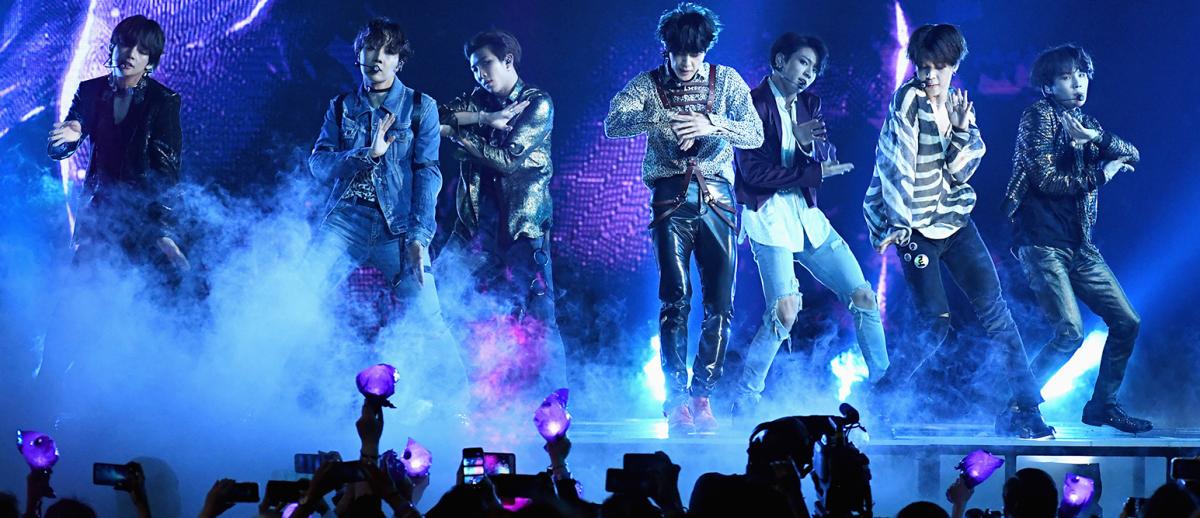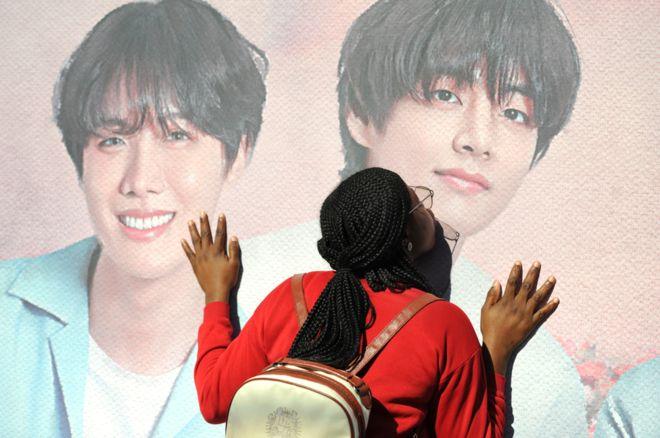Global K-Pop, or How to Aestheticize with a Hammer
archive


BTS performs during 2018 Billboard Music Awards in Las Vegas, May 20, 2018. (Image source: Ethan Miller/Getty Images)
Global K-Pop, or How to Aestheticize with a Hammer
‘Hammer the Heart’ might sound faintly alarming to those unversed in the language of K-Pop, but the edict is not hard to understand. There is the music that you listen to in devotional silence, sitting upright in a concert chamber—the kind that elevates the soul. Then there is the kind of music that pumps and hammers the heart into a frenzy. The latter is said to be the kind that Bang Shihyuk (방 시혁), producer of the band BTS, is interested in making.1 And it serves more broadly as a defining feature of K-Pop.
2019 marks the year when K-Pop scaled up to the global stage via BTS. On their most recent ‘Speak Yourself’ tour, BTS sold out stadiums in Los Angeles, Chicago, New Jersey, Sao Paulo, London, Paris, and Osaka. They have had three No. 1 albums on the Billboard 200 in the past year (‘18 –’19), a feat only equaled by the Beatles in ‘95-96 (archival releases) and the Monkees in 1967. ‘Boys with Luv’, their last single, racked up 78 million views in 24 hours on YouTube, setting a world record.
One might wave all this away on the grounds that boy bands are nothing new. That would be true. What is new, however, is that BTS sings in Korean. A cultural product in a non-European language has virtually no chance of having any presence in the Western world—let alone a series of No. 1 hits on the U.S. Billboard charts.
Popular music in the West may appear to be governed by the free-market in the sense that the success of an act is determined by audience preference. But that is not the complete picture. Because the ‘audience’ is not the market but the advertisers. The reality is that Western music institutions shape the global music industry by selecting, directing, packaging, and promoting performers whose music we download for free. It is the fate of the (g)locals around the world to adapt to it. Before the emergence of K-Pop onto the global stage, no U.S. advertiser would have considered a Korean-language album as a product worth endorsing.
So how did BTS do it? How did they overcome what appears to be insuperable impediments to build a diverse global fan-base? The short answer is: by by-passing existing gatekeepers. BTS debuted in 2013 and pioneered direct bonding between star and fan. Theirs was music cultivated through social media, initially in the Global South, not via recording labels and Western media. The digital strategy of Big Hit Entertainment, BTS’s agency, is to focus on fostering an emotional connection between the pop stars and their audience by providing a constant flow of free but high-quality content online. In parallel and in combination with their live performances are a steady stream of polished rehearsal videos, intimate individual vlogs, and engaging back-stage clips as well as tour documentaries and nearly a dozen reality-show series such as Run BTS! and American Hustle Life.
A key factor in the star-fan bonding is the role played by the seven members off-stage. Jin, Suga, RM, J-Hope, Jimin, V, and Jungkook participate directly and explicitly for ARMY, a collective name for BTS fans. What may seem like self-promotion in other pop acts comes across instead as tributes to their fans, such is the seeming sincerity and modesty of the members’ social media identities. There is the highly private, confessional tone of vlogs alongside the goofy chumminess of the reality shows. RM, Suga, and J-Hope released their ‘mixtapes’ through Sound Cloud for ARMY while Jungkook shot, edited, and released his G.C.F. music video series online. Jin runs an eating vlog so he can ‘share’ his meals with his fans. The glossy, dazzling perfection of their music videos is thrown into relief by the relatability that permeates their life-style uploads, fatally blurring the line between idol and friend to the digital-native adolescent.

Image source: BBC
There is, of course, a more intricate and complex answer to the question of how BTS did it, which cannot be properly examined in this short article, beginning with the fetching charm of each of the seven members—lovingly chronicled in countless fancam compilations, which a cursory YouTube search will swiftly divulge. But to address the question of how a small struggling talent agency in Seoul founded in 2005 came to be valued at over 1 billion dollars in 2019, we need to return to Bang, or ‘Hitman Bang’ as he is known in Korea, the CEO of Big Hit Entertainment.2
You might assume that the executive heading a company at the forefront of K-Pop is a ruthless mogul. Far from it. In fact, Bang is an aesthete. He read aesthetics at Seoul National University (graduating second in his class) before spending several years as a composer and producer at JYP, one of the three major K-pop agencies. In an industry driven by profit, a CEO aesthete might seem like a contradiction, especially to those in whose minds creativity and beauty mean the opposite of capitalist utility. In Bang’s vision, however, the gratuitous, self-fulfilling, non-instrumental threads of beauty are only made meaningful when it has the means to reach a mass audience.
Since the turn of the century, Bang, together with Park Jinyoung (박 진영), singer and the CEO of JYP, produced a stream of successful acts stabilizing the concept of K-Pop as a genre. Their creation of g.o.d, a ‘version-one’ K-Pop boy band, swept South Korea like wildfire in the early-2000s, followed by Rain (비) who stormed South-East Asia in the mid-2000s. Yet in his years as a hit-maker, Bang often felt frustrated. His predicament was this: “When you make (Korean) films, you can subtitle them and take them abroad. But what can you do with Korean pop music? You can’t subtitle the lyrics.” The problem of language focused his art around a central question: how do you communicate and connect with people when the language you speak is unknown to the rest of the world?
Before the emergence of K-Pop onto the global stage, no U.S. advertiser would have considered a Korean-language album as a product worth endorsing.
What emerged was a process of innovation to create a new form of music—visual music. As Bang has explained: “K-Pop is visual music.”3 The visuals are not extraneous to the lyrics but rather constructed and thematized as part of the music itself. BTS videos are not secondary to a song that you hear on the radio first. Instead you encounter the song first through the music video, the memory of which overlays the listening on Spotify. Of course, pop stardom always requires some quality of surface and flash but the attention to detail Big Hit devotes to the staging of their videos is striking for its ambitious visual aesthetics. Their performances are as spectacular and precise as a sequence of fireworks. And they are better seen than described. For those new to K-Pop, I would recommend 1) ‘Fire’, the choreography version; 2) ‘Mic-drop’, the MAMA 2017 live performance; and 3) ‘Blood Sweat and Tears’, the original MV.
The substance of the fantasy created by these spectacles depends on what the performers can visually project. Bang has said that the quality of an Idol is measured in proportion to his/her capacity to dominate the stage and he does not shy away from declaring the centrality of what is known in the K-Pop industry as the ‘visuals’ of his trainees. Korean idols are selected for the right looks and the right build, as well as their ability to master singing, dancing and acting. This is not dissimilar, in principle, to the selection process of other performance institutions such as the Royal Ballet school or the circus.
Projecting images through the Idol system does not stop at the level of individual personas. BTS members appear to have been trained to develop a magical sixth sense to work together as a team. Their synchronicity brings trapeze artists to mind, so emotionally and physically in tune are they with each other on stage and off. They seem to support each other unstintingly through every challenge, in a manner last found in The Waltons or the Little House on the Prairie. They represent a glamorous embodiment of distinctly non-rock’n’roll values such as industriousness, selflessness, and moral awareness. In the age of selfies and digital narcissism, their humility is as conspicuous as it is moving. This central and formative component is very much part of their appeal to a very diverse group of fans of all ages, backgrounds, and nationalities.
Social media bonding and visual aesthetics are strategies not unique to BTS. In fact, they are a shining example of the distinctive attributes that befit the digital age. It remains to be seen whether aestheticizing with a hammer will form a general line of intervention led from the peripheries in an emerging global mass culture. Whatever the case, the new standard BTS has set for minority cultures is profoundly encouraging.4
1. Source, People Inside interview, 2011. See https://www.youtube.com/watch?v=JAelmbxhPIw
2. Source from Hyundai Research Institute. See https://www.billboard.com/articles/business/8514793/bts-agency-big-hit-entertainment-valued-over-1-billion
3. Source, KBS Myung Kyun Man Li. See https://www.youtube.com/watch?v=CQA3Xl6P5uk
4. Some readers may note the allusion to Nietzsche’s subtitle of The Twilight of the Idols - How to Philosophize with a Hammer. The abiding influence of Nietzsche on the story-world of BTS is a topic worthy of further investigation, which the scope of this essay does not, alas, permit.



